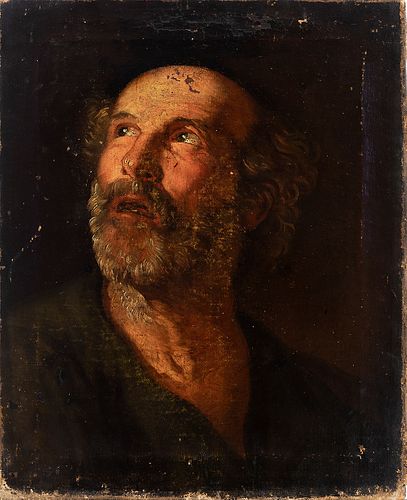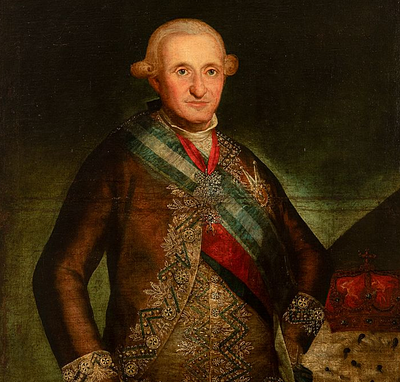Circle of JUAN RIBALTA (Madrid, c. 1596-Valencia, 1628). "San Pedro". Oil on canvas.
Lot 4
About Seller
Setdart Auction House
Carrer Aragó 346
Barcelona
Spain
Setdart Subastas was born in 2004 and is currently the first online art auction in Spain with solidity, prestige and reliability guaranteed by our more than 60,000 users. Setdart has a young, dynamic and enterprising team ready to successfully manage the purchase and sale of art works through custom...Read more
Estimate:
EUR€3,000 - EUR€4,000
$3,092.78 - $4,123.71
Absentee vs Live bid
Two ways to bid:
- Leave a max absentee bid and the platform will bid on your behalf up to your maximum bid during the live auction.
- Bid live during the auction and your bids will be submitted real-time to the auctioneer.
Bid Increments
| Price | Bid Increment |
|---|---|
| EUR€0 | EUR€10 |
| EUR€200 | EUR€25 |
| EUR€500 | EUR€50 |
| EUR€1,000 | EUR€100 |
| EUR€3,000 | EUR€200 |
| EUR€5,000 | EUR€500 |
| EUR€10,000 | EUR€1,000 |
| EUR€20,000 | EUR€2,000 |
| EUR€50,000 | EUR€5,000 |
About Auction
By Setdart Auction House
Sep 22, 2021
Set Reminder
2021-09-22 09:30:00
2021-09-22 09:30:00
America/New_York
Bidsquare
Bidsquare : 22nd September - ARAS JÁUREGUI Private Collection - Old Masters, 19th & 20th Century
https://www.bidsquare.com/auctions/setdart-auction-house/22nd-september---aras-j-uregui-private-collection---old-masters-19th-20th-century-7427
ARAS JÁUREGUI Private Collection - Old Masters, 19th & 20th Century Setdart Auction House sofia@setdart.com
ARAS JÁUREGUI Private Collection - Old Masters, 19th & 20th Century Setdart Auction House sofia@setdart.com
- Lot Description
Circle of JUAN RIBALTA (Madrid, c. 1596-Valencia, 1628). "San Pedro". Oil on canvas. The original canvas is preserved. It presents faults, repainting and old restorations. Measurements: 44 x 36 cm. Saint Peter (Bethsaida, c. 1 B.C. - Rome, 67) was, according to the New Testament, a fisherman, known for being one of the twelve apostles of Jesus. The Catholic Church identifies him through the apostolic succession as the first Pope, based among other things on Jesus' words to him: "You are Peter, and on this rock I will build my Church, and the power of Death shall not prevail against it. I will give you the keys of the Kingdom of Heaven. Whatever you bind on earth shall be bound in heaven, and whatever you loose on earth shall be loosed in heaven". St. Peter could be said to have been Jesus' confessor, his closest disciple, the two being united by a very special bond, as narrated in both the canonical and apocryphal Gospels. Juan Ribalta (Madrid, c. 1596-Valencia, 1628) was a Baroque painter who developed his career in the city of Valencia. He began his artistic training under the guidance of his father, the renowned artist Francisco Ribalta, a follower of Caravaggist painting. Always linked to the workshop of his father Juan Ribalta, he signed his first work at the age of eighteen in his father's workshop. Three years later, in 1618, he married, thus achieving an advantageous economic position, and began to associate himself with the world of literature. His pictorial work is characterised by a tenebrist aesthetic style very close to the pictorial quality of his father. However, Juan Ribalta was initially based on the precepts of Mannerism, to which he applied certain naturalistic touches. Later his painting began to show a certain interest in the anecdotal and the everyday, characteristics that were widely present in the workshop of Bassano, an artist who greatly influenced him. In his last period, his painting veered towards a much more sober, naturalistic language, again close to that of his father. However, despite his father's fame, Juan Ribalta's talent was highly appreciated; in fact, Palomino was a great defender of his work, dedicating these words to him: "in that the father's manner was more defined, and the son's somewhat looser and more beaten". However, it should be noted that his untimely death left us the work of a great painter who was still shaping his own pictorial language.
- Shipping Info
-
In-house shipping available. Please inquire at admin@setdart.com.
-
- Buyer's Premium



 EUR
EUR CAD
CAD AUD
AUD GBP
GBP MXN
MXN HKD
HKD CNY
CNY MYR
MYR SEK
SEK SGD
SGD CHF
CHF THB
THB















